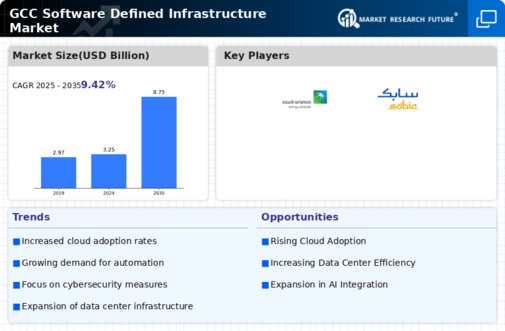The software defined-infrastructure market is currently characterized by a dynamic competitive landscape, driven by rapid technological advancements and increasing demand for flexible IT solutions. Key players such as VMware (US), Cisco (US), and Hewlett Packard Enterprise (US) are strategically positioning themselves through innovation and partnerships. VMware (US) focuses on enhancing its cloud infrastructure capabilities, while Cisco (US) emphasizes network automation and security integration. Hewlett Packard Enterprise (US) is actively pursuing regional expansion, particularly in the GCC, to capitalize on the growing digital transformation initiatives across various sectors. Collectively, these strategies contribute to a competitive environment that is increasingly focused on delivering integrated solutions that meet the evolving needs of enterprises.
In terms of business tactics, companies are localizing manufacturing and optimizing supply chains to enhance operational efficiency. The market appears moderately fragmented, with several key players exerting significant influence. This structure allows for a diverse range of offerings, enabling companies to cater to specific customer needs while fostering competition that drives innovation and service quality.
In October 2025, VMware (US) announced a strategic partnership with a leading cloud service provider to enhance its multi-cloud capabilities. This move is likely to strengthen VMware's position in the market by providing customers with more robust and flexible cloud solutions, thereby addressing the increasing demand for hybrid cloud environments. The partnership underscores VMware's commitment to innovation and its focus on delivering comprehensive infrastructure solutions.
In September 2025, Cisco (US) launched a new suite of security-focused software defined networking solutions aimed at enhancing enterprise security in cloud environments. This initiative reflects Cisco's strategic emphasis on integrating security into its infrastructure offerings, which is increasingly critical as cyber threats evolve. By prioritizing security, Cisco positions itself as a leader in providing secure and reliable infrastructure solutions, appealing to organizations that prioritize data protection.
In August 2025, Hewlett Packard Enterprise (US) unveiled its latest edge computing solutions designed to optimize data processing at the source. This strategic move aligns with the growing trend towards edge computing, which is essential for real-time data analytics and IoT applications. By investing in edge technology, HPE is likely to enhance its competitive edge, catering to businesses seeking to leverage data-driven insights for operational efficiency.
As of November 2025, current trends in the software defined-infrastructure market include a strong focus on digitalization, sustainability, and AI integration. Strategic alliances are increasingly shaping the competitive landscape, enabling companies to leverage complementary strengths and enhance their service offerings. Looking ahead, competitive differentiation is expected to evolve, with a shift from price-based competition towards innovation, technology, and supply chain reliability. This transition suggests that companies that prioritize technological advancements and sustainable practices will likely emerge as leaders in the market.

















Leave a Comment